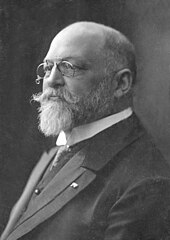Ottomar Reichelt
Ottomar Reichelt (born July 4, 1853 in Spremberg , † December 26, 1911 in Dresden ; full name: Karl Ottomar Reichelt or Carl Ottomar Reichelt ) was a German architect and high-ranking Saxon building official who worked mainly in Dresden.
Life
From 1898 Reichelt was head of the Dresden Landbauamt I. He ended his career in the Saxon civil service as a lecturer in the Saxon Ministry of Finance in Dresden with the rank of a secret building councilor. Together with Edmund Waldow, he was entrusted with the management of the entire Saxon structural engineering sector.
Reichelt's grave is in the Johannisfriedhof in Dresden.
plant
Ottomar Reichelt created important public buildings in Dresden during his tenure.
In the years 1889–1896, the Saxon State Ministry of Finance was built on the Neustädter Elbe bank according to designs by Otto Wanckel (1820–1912) and Ottomar Reichelt , a government building in the neo-Renaissance style , with which the Kingdom of Saxony wanted to represent the Elbe front.
Between 1900 and 1903 originated in the Johannstadt under Reichelt's construction management one designed by him a new building for the Women's Clinic of today's City Hospital Dresden-Johannstadt . He wrote a description of the construction and operation of the women's clinic in 1906 together with the gynecologist Christian Gerhard Leopold in the book Die neue Königliche Frauenklinik in Dresden .
The main state archive in Dresden , designed in collaboration with the building inspector Heinrich Koch , which he had been commissioned to plan in 1908, could no longer be carried out by Reichelt due to his death in December 1911. Koch took on the further planning and was in charge of construction from 1912 to 1915.
Web links
- Record Reichelt, Karl Ottomar (Seq. No. 243) in the online database of the portal historismus.net , last accessed 5 February 2012
Individual evidence
- ↑ a b death survey . In: Dresdner Geschichtsblätter 21 (1912), p. 234. ( online at slub-dresden.de , Sächsische Landesbibliothek - Staats- und Universitätsbibliothek Dresden , accessed on February 12, 2013 (link to the resource next to the catalog entry); there also as PDF ; 78.55 MB.)
- ↑ The literature used for the article (as of February 10, 2013) as well as other viewed written sources use "Karl", the tombstone and a stained glass window in the Saxon Central State Archives (photos in Wikimedia Commons , both accessed on July 24, 2012), however, "Carl" as spelling for the first name.
- ↑ Volker Helas : Architecture in Dresden 1800–1900. Vieweg, Braunschweig / Wiesbaden 1985, ISBN 3-528-08696-3 , p. 198.
- ^ Jürgen Paul: Urban development and architecture . In: Holger Starke (Hrsg.): History of the City of Dresden, Volume 3: From the foundation of an empire to the present . Theiss, Stuttgart 2006, p. 83.
- ^ Christian Gerhard Leopold , Karl Ottomar Reichelt : The new royal gynecological clinic in Dresden. (= Work from the Royal Women's Clinic in Dresden , Volume 3.) Hirzel, Leipzig 1906, p. 5, p. 10 f. ( online at slub-dresden.de , Sächsische Landesbibliothek - Staats- und Universitätsbibliothek Dresden, accessed on July 24, 2012 (link to the resource next to the catalog entry); there also as PDF ; 21.23 MB.)
- ^ Ingrid Grohmann : The building of the Dresden State Archives and its predecessors. In: Archive Messages , Volume 35 (1985), p. 196.
| personal data | |
|---|---|
| SURNAME | Reichelt, Ottomar |
| ALTERNATIVE NAMES | Reichelt, Carl Ottomar; Reichelt, Karl Ottomar (full name) |
| BRIEF DESCRIPTION | German architect and high-ranking Saxon building official |
| DATE OF BIRTH | 4th July 1853 |
| PLACE OF BIRTH | Spremberg |
| DATE OF DEATH | December 26, 1911 |
| Place of death | Dresden |

